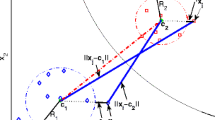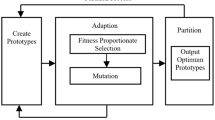Abstract
The traditional sphere-structured support vector machines algorithm is one of the learning methods. It can partition the training samples space by means of constructing the spheres with the minimum volume covering all training samples of each pattern class in high-dimensional feature space. However, the decision rule of the traditional sphere-structured support vector machines cannot assign ambiguous sample points such as some encircled by more than two spheres to valid class labels. Therefore, the traditional sphere-structured support vector machines is insufficient for obtaining the better classification performance. In this article, we propose a novel decision rule applied to the traditional sphere-structured support vector machines. This new decision rule significantly improves the performance of labeling ambiguous points. Experimental results of seven real datasets show the traditional sphere-structured support vector machines based on this new decision rule can not only acquire the better classification accuracies than the traditional sphere-structured support vector machines but also achieve the comparable performance to the classical support vector machines.




Similar content being viewed by others
References
Kulkarni SR, Lugosi G, Venkatesh SS (1998) Learning pattern classification: a survey. IEEE Trans Inf Theory 44(6):2178–2206
Jain AK, Duin RPW, Mao J (2000) Statistical pattern recognition: a review. IEEE Trans Pattern Anal Mach Intell 22(1):4–37
Burges JC (1998) A tutorial on support vector machines for pattern recognition. Data Min Knowl Dis 2(2):121–167
Zhu ML, Chen SF, Liu XD (2003) Sphere-structured support vector machines for multi-class pattern recognition. Lect Notes Comput Sci 2639:589–593
Schölkopf B, Burges C, Vapnik V (1995) Extracting support data for a given task. In: Proceedings of the first international conference knowledge discovery data mining, pp 252–257
Tax DMJ, Duin RPW (1999) Data domain description by support vectors. In: Verleysen M (ed) Proceedings ESANN. D. Facto, Brussels, pp 251–256
Wolfe P (1961) A duality theorem for nonlinear programming. Q Appl Math 19:239–244
Kukn HW, Tucker AW (1951) Nonlinear programming. In: Proceedings of second Berkeley symposium on mathematical statistics and probability, pp 481–492
UCI Machine Learning Repository: http://www.ics.uci.edu/~mlearn/MLRepository.html
LibSVM Datasets. http://www.csie.ntu.edu.tw/~cjlin/libsvmtools/datasets
Acknowledgments
We thank the anonymous reviewer’s constructive comments for improving presentation of this article.
Author information
Authors and Affiliations
Corresponding author
Additional information
An erratum to this article can be found at http://dx.doi.org/10.1007/s00521-008-0197-z
Rights and permissions
About this article
Cite this article
Gu, L., Wu, Hz. Applying a novel decision rule to the sphere-structured support vector machines algorithm. Neural Comput & Applic 18, 275–282 (2009). https://doi.org/10.1007/s00521-008-0179-1
Received:
Accepted:
Published:
Issue Date:
DOI: https://doi.org/10.1007/s00521-008-0179-1




